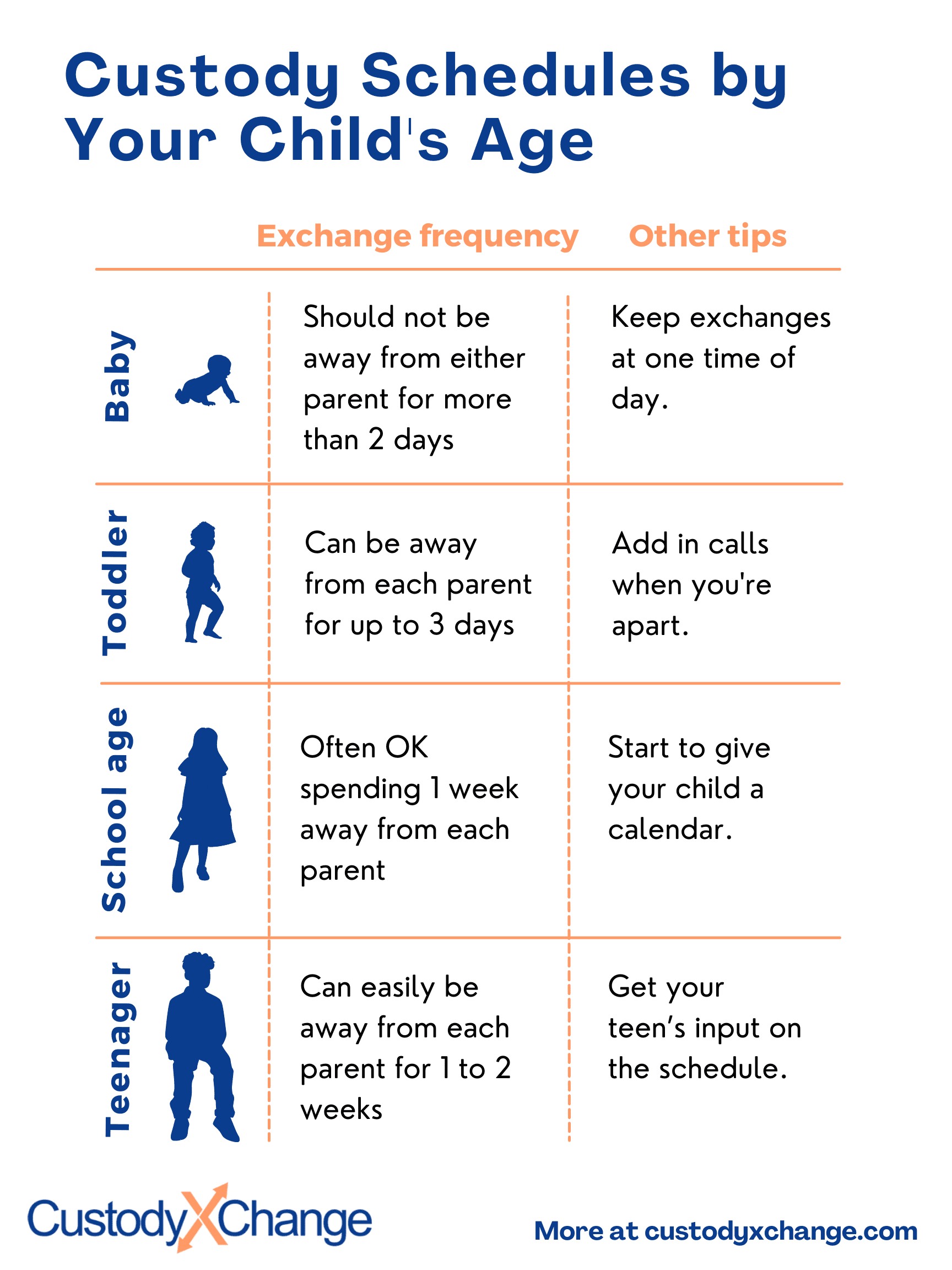Baby Parenting Plans and Custody Schedules
(birth to 18 months)
A parenting plan for a baby has all of the information of a basic parenting plan, but it is customized to fit the unique needs of a baby (birth to 18 months).
Making a parenting plan for an infant
Here are some things you need to know about babies to make your parenting plan more effective.
- Babies need consistency. Your plan should allow your baby to have a predictable routine for sleeping, waking and eating.
- Babies have a limited capacity to remember. Your plan should give your baby frequent contact with both parents.
- Babies change and grow rapidly. Your plan should have a way for the parents to communicate about the baby's development, and as your baby grows, you should adjust your plan to fit your baby's needs.
- Babies feel fear and recognize anger and harsh words. Your plan needs to provide a way for parents to work out disagreements so that your baby isn't around conflict.
If your baby is breastfeeding, you should include related information in your plan. This includes feeding time and whether your baby can drink from a bottle. Plan custody exchanges around your baby's feeding and sleeping schedules.
Consider adding a communication provision to ensure you're regularly communicating about the baby's eating, sleeping and diapering routines and new developments. You might use Custody X Change messaging or print or email your Custody X Change journal entries.
Making a custody schedule for an infant
Your custody schedule should give your baby frequent contact with both parents, and your baby should not be away from either parent for more than a few days.
Usually, an infant lives with one parent and has visits with the other. The nonresidential parent should have several visits a week with the baby. The visits should give the parent opportunities to feed, bathe and soothe the baby, as well as play with them and put them to sleep.
Here is an example of a visitation schedule for a baby.
 You can customize this with Custody X Change.
You can customize this with Custody X Change.
While parenting experts once recommended daytime visits only, many now advise overnight time for nonresidential parents when possible. Incorporate overnights in a way that makes the baby feel secure. You can start with one overnight per week, then increase to more once your baby is ready.
 You can customize this with Custody X Change.
You can customize this with Custody X Change.
When both parents work during the week and the baby is in daycare, a common schedule is for the parents to split the weekend. In addition, during the week the nonresidential parent has one overnight visit.
 You can customize this with Custody X Change.
You can customize this with Custody X Change.
The following schedules can also work for a baby:
- 2-2-3 schedule, where your baby spends 2 days with one parent, 2 days with the other parent and then 3 days again with the first parent.
- Alternating every 2 days schedule, where your baby alternates spending 2 days with each parent.
- 5-2 schedule, where your baby spends 5 days with one parent and 2 days with the other parent. You'd want to add midweek visits to this schedule.
- Every 3rd day schedule, where your child spends every 3rd day with the nonresidential parent.
Babies may have a caregiver preference and feel anxious when separated from that parent for too long. You may need to adjust your schedule if that happens.
If an absent parent wants to get involved in the baby's life, you can start with a schedule that gives the parent a few short visits during the week (perhaps at the baby's home). As the parent becomes more competent with caregiver skills, the visits can go longer, even overnight.
The holiday schedule for a baby typically includes a few important holidays like Christmas, Thanksgiving, Mother's Day and Father's Day. The baby spends a few hours with each parent on or around the holiday. You can increase the number of holidays in your schedule and the length of holiday time as your baby gets older.

Development from birth to 18 months
Understanding some of the development changes a baby may go through from birth to 18 months can help you make a better parenting plan for your baby.
Babies grow and develop rapidly during this time. Here are some of the ways they develop:
- Motor skills: crawling, standing and walking
- Communication: sounds, smiles, pointing and simple words
- Expressions of emotions: hugs, kisses, cuddling, anger, frustration and fear
Babies can form attachments to multiple caregivers. They bond with parents and other caregivers who hold, feed, soothe, play with, talk to and meet their needs. Around six months old, a baby can recognize parents and caregivers and may start to have stranger anxiety. Stranger anxiety can last until the baby is a toddler.
Babies have a limited capacity to remember, but they do have emotional memories. They will remember feeling frightened, and they can recognize anger and harsh words.
Get help with infant parenting plans and schedules
Creating a plan and schedule on your own can feel overwhelming. You have to be sure to use airtight legal language and can't omit any required information.
The Custody X Change app takes the guesswork out of the equation. It walks you through each step of creating a parenting plan and helps you build a schedule piece by piece.
Try this with Custody X Change.
As a result, you get documents and calendars that meet your family's needs, as well as the court's standards.
For quick, reliable and affordable help making a parenting plan and custody schedule, turn to Custody X Change.
